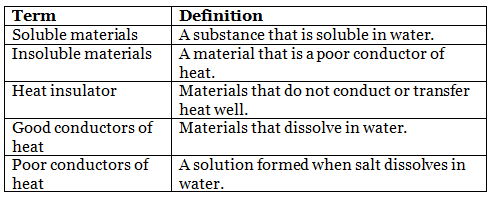Sorting Materials into Groups Class 6 Worksheet Science Chapter 2
Q1: Multiple Choice Questions (MCQs)
(i) What are the three main states of matter?
(a) Solids, liquids, and gases.
(b) Solids, liquids, and powders.
(c) Metals, plastics, and ceramics.
(d) Wood, paper, and glass.
(ii) Which of the following is a good conductor of heat?
(a) Water
(b) Copper
(c) Plastic
(d) Wood
(iii) What property determines whether an object will float or sink in water?
(a) Color
(b) Density
(c) Shape
(d) Hardness
(iv) Which materials are good conductors of electricity?
(a) Plastics
(b) Glass
(c) Metals
(d) Wood
(v) What is the primary reason for classifying materials based on their properties?
(a) To make materials harder
(b) To make materials softer
(c) To understand how materials behave and use them effectively
(d) To make materials transparent
Q2: Fill in the Blanks
(i) Materials through which light passes completely are called ____________.
(ii) When a material dissolves in a liquid, a ____________ is formed.
(iii) Objects that are denser than water will ____________ in water.
(iv) ____________ is used to shield things from heat.
(v) Fine ceramics are used for making computer chips, heat-insulating devices, and components of spaceships due to their properties of being extremely ____________, melting at very high temperatures, and being poor conductors of electricity and heat.
Q3: Match the Column (In a Table)
Match the terms on the left with their corresponding definitions on the right:

Q4: True or False
(i) All metals are poor conductors of heat.
(ii) Glass is a transparent material.
(iii) Solids have a definite shape and volume.
(iv) Wood is an excellent conductor of electricity.
(v) A heat insulator can be used to shield things from heat.
You can access the solutions to this worksheet here.
|
124 docs|8 tests
|
FAQs on Sorting Materials into Groups Class 6 Worksheet Science Chapter 2
| 1. What are the different types of materials that can be sorted into groups? |  |
| 2. Why is it important to sort materials into different groups? |  |
| 3. How can we identify different materials for sorting? |  |
| 4. What are some common examples of each material group? |  |
| 5. How can sorting materials help the environment? |  |















